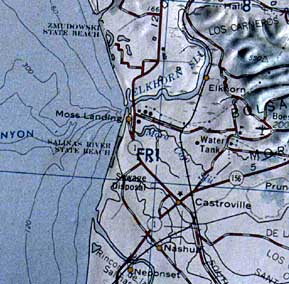 By
far the best waterbird habitat in Monterey County is the Moss Landing/Elkhorn
Slough vicinity; indeed, this tidal slough and adjacent freshwater ponds
combine for some of the best birding in all of North America. It has been
recognized as an Important Bird Area (IBA) of international significance.
Along with the much larger San Francisco & Humboldt bays farther north,
it is a principal staging and feeding area for migratory shorebirds. By
far the best waterbird habitat in Monterey County is the Moss Landing/Elkhorn
Slough vicinity; indeed, this tidal slough and adjacent freshwater ponds
combine for some of the best birding in all of North America. It has been
recognized as an Important Bird Area (IBA) of international significance.
Along with the much larger San Francisco & Humboldt bays farther north,
it is a principal staging and feeding area for migratory shorebirds.
Elkhorn Slough is located right in the center of the curve of Monterey
Bay (map right) and drains directly into the Pacific Ocean through the
Moss Landing harbor channel. Before the channel was created (1946) and
the rivers diverted (1908-1910), the Salinas River ran north from its present
mouth to its old original mouth north of today's Moss Landing. Today's
Moss Landing harbor and various sloughs to the south are part of this old
river bed.
The Monterey Bay Aquarium has published a fine introductory guide to
Elkhorn Slough by Mark Silberstein and Eileen Campell (1989); in addition,
the Elkhorn Slough Foundation
has extensive information on-line (and a detailed
map). I can offer only a few highlights here directed to the field
birder (more details were published in Roberson 1985). Moss Landing harbor
is easily accessible to all, but public access to the Slough is limited
to a few points -- primarily Elkhorn Slough Estuarine Research Reserve
and Kirby Park in the upper reaches of the slough. Another great way to
bird the area is from the Elkhorn Slough
Safari pontoon boat rides; the trips leave from the Moss Landing marina
(extreme lower right in photo below).
|
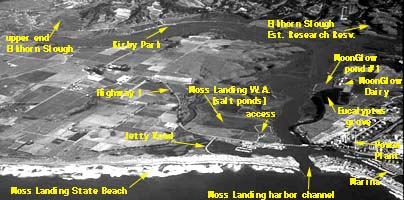 Mark
Silberstein's wonderful aerial photo shows essentially all of Elkhorn Slough
and Moss Landing harbor. Locate principal sites, especially those of birding
interest, on the legend (left) and then find them on Mark's overview photo
(below). This view is looking east from Monterey Bay. Highway runs through
the center of the photo; to the north (out the upper left side of the photo)
this road goes to Santa Cruz, and to the south (lower right side) it heads
toward Monterey. Highway 1 crosses Elkhorn Slough at the lower right center
of the shot; the huge power plant (built by PG&E, now run by Duke Power)
is just south (right) of that prominent bridge. Mark
Silberstein's wonderful aerial photo shows essentially all of Elkhorn Slough
and Moss Landing harbor. Locate principal sites, especially those of birding
interest, on the legend (left) and then find them on Mark's overview photo
(below). This view is looking east from Monterey Bay. Highway runs through
the center of the photo; to the north (out the upper left side of the photo)
this road goes to Santa Cruz, and to the south (lower right side) it heads
toward Monterey. Highway 1 crosses Elkhorn Slough at the lower right center
of the shot; the huge power plant (built by PG&E, now run by Duke Power)
is just south (right) of that prominent bridge. |
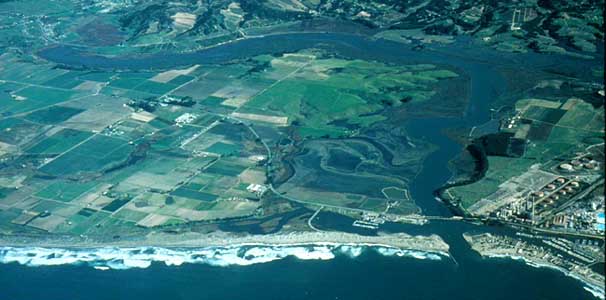
|
Primary birding spots: there are many places to check but a
lot depends on time of year and the weather. Weather can be important as
the wind tends to kick up in the afternoon. Alternatively, morning fog
can keep things quiet. Some of the best spots are:
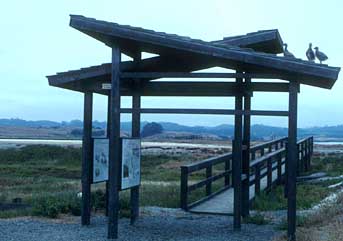
-
Moss Landing Wildlife Area and the Moss Landing harbor --
the old salt ponds on the inland (east) side of Highway 1, just north of
Elkhorn Slough, are now a State Wildlife Area(W.A.).
The ponds are controlled by tidal gates; those near the Slough are great
for shorebirds and a major roost of Brown Pelicans. There is also a Harbor
Seal pupping area. The more northerly ponds are mostly kept dry from an
important breeding colony of endangered Snowy Plovers. Access used to be
through trails beginning at the northeast corner of the W.A. but currently
that access point and the trails are closed. Access is now available through
a gate portal (right) that includes explanatory signs about the area, and
that leads to a trail along Elkhorn Slough itself for a short distance.
A scope is often needed here to view the dry ponds (on which terns roost
in fall), the pelican roost area, and the many happenings in the Slough
(sea otters and sea ducks are common). This access area is reached from
Highway 1 just north of the bridge over Elkhorn Slough through a short
dirt road that is sign-posted (labeled "access" in the photo legend above).
The access to Moss Landing W.A. is thus east (inland) of Highway 1, but
just opposite -- to the west -- is the Moss Landing
harbor and vicinity. There is public access just north of the
bridge over Elkhorn Slough to a large parking area for restaurants [the
most famous to birders was "Skipper's Restaurant" but it burned down 25
Ap 1998 and at the date of this writing in Sept 2000 had still not been
rebuilt]. From this parking area and the nearby boat ramp to the north
one has views of Moss Landing harbor. Sea ducks, loons, grebes and gulls
are the specialties here, and in winter all 3 scoters may be present (Black
is rare) plus an occasional Long-tailed Duck, Red-necked Grebe, or something
even better (Emperor Goose in 1978).
|
|
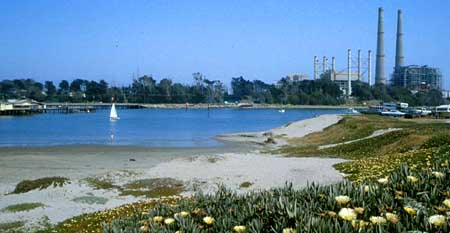
-
Jetty Road and Moss Landing State Beach -- this turn-off about a
half-mile north of the Highway 1 bridge over the Elkhorn Slough is well
marked. Almost immediately one has tidal mud flats to the left and right
of the road, but the only legal parking is down to the right near the kiosk
that goes to the State Beach. This is a very fine area for migrant shorebirds
and terns; Red Knots are regular spring & fall, and a few winter. Things
change rapidly as the tide moves in and out (at high tide all flats can
be covered; in the photo below the tide is getting high and the mudflats
south of Jetty Road have become an isolated island). There is a fee to
drive into the State Park but the views from the parking areas beyond the
kiosk back into the harbor can be superb. The shot (right) shows the harbor,
the dominating Moss Landing power plant, and the final parking area at
the base of the north jetty. About half-way to the end there is a standard
gull roost at harbor's edge and views from the State Park are best in the
afternoon. Many rare species have visited this roost, including Swallow-tailed,
Glaucous, Iceland, Franklin's and Laughing gull. At road's end there is
a parking area and one can walk to the jetty on the north side of the harbor.
The entire State Beach itself is full of birds -- gulls, terns diving offshore
in season, shorebirds, flocks of Snowy Plover in season, and rarities such
as Wilson's & Mongolian Plover have been with these flocks. Huge swirling
flocks of Sooty Shearwaters can be just offshore in spring through fall.
|
|

|
-
Zmudowski State Beach -- another fabulous waterbird area is north
of Jetty Road. Just north of Jetty Road the highway turns back east for
a short distance and Struve Road exits to the left. Take Struve to the
first left (Giberson) and follow that zig-zagging paved road to Zmudowski
S.B. at the end (there are signs). There is a fine freshwater pond just
before the end of the road where many interesting ducks and other rarities
(Little Gull, White-faced Ibis) have occurred. American Bitterns, Snowy
Egrets, and night-herons nest in the reeds at the north end of the pond.
From the State Beach parking lot one can walk the beach the half-mile to
the Pajaro R. mouth which always has a host of roosting gulls, and many
terns in summer. Lots of rarities here over the years. Both sides of the
Pajaro R. mouth are usually in Monterey County, but the Pajaro Dunes colony
north of the river, and a short stretch of beach south, are within Santa
Cruz County. [Do be aware there have been some car break-ins at the Zmudowski
S.B. parking lot in the past.]
-
Moss Landing "island" and the South Jetty -- the town of
Moss Landing is accessed off Highway 1 just south of the power plant and
the bridge over Elkhorn Slough. A loop road goes through the tiny town
(which is famous for antique stores) and connects back up with Highway
1 a short distance farther south (Moss Landing Marine Lab and a cemetery
are along the south end of this loop). In the middle of town the only cross-street
(Sandholt) heads past the Moss Landing marina (where one begins the Elkhorn
Slough safari boat trip) and over a one-way bridge
to Moss Landing "island" (actually a thin peninsula that ends at the south
jetty to Moss Landing harbor). There is a parking lot for the state beach
at the north end of the one-way bridge, and this lot, plus both ends of
the bridge, given good views to other tidal areas of south Moss Landing
harbor. [In fact, in crossing the one-way bridge you are crossing the old
Salinas River channel.] When tides and seasons are right, this area is
great from shorebirds, grebes, ducks, and Brant. The paved road meanders
through various ship-docking areas and shops and dead-ends at the South
Jetty. Park here and walk the very short distance to the base
of the jetty; bring a scope. Four species of loons (three regular, Yellow-billed
very rare) have been found here, all the sea-ducks (including the very
rare King Eider), all the grebes, and there is always a chance for alcids.
Common Murres are often just outside the jetties year-round as are Pigeon
Guillemots in late summer. Rarer species have also been seen. Parasitic
Jaegers often chase Elegant Terns at the harbor mouth in fall.
-
Potrero Road -- at the south end of Moss Landing town, Potrero Road
heads west and ends at another access point for the State Beach. Right
at the end the road crosses the old Salinas River channel again; this is
another good shorebird area in season. The artichoke fields to the south
are hunted by a wide selection of raptors in winter; these fields can also
be viewed along Molera Road which loops through them and back to Highway
south of Castroville.
-
Dolan Road -- Dolan Rd. goes inland from Hwy 1 at the Moss Landing
power plant. Elkhorn Road intersects it about 3 miles inland; one follows
Elkhorn Road north (left) to reach Elkhorn Slough Estuarine Research Reserve
and the upper end of Elkhorn Slough. Just before (west) of Elkhorn Road,
Castroville Blvd. goes south (right) and connects with Highway 156 near
Castroville. Dolan Road and Castroville Blvd. both have views of Moro Cojo
Slough (south of Dolan Road; Castroville Blvd. crosses the upper end of
Moro Cojo Slough). Scopes are needed but the slough often has a wide variety
of ducks and shorebirds. Dolan Road passes through cattle-grazing land,
and sometimes Cattle Egrets are with cows in fall/winter. The swirling
blackbird flocks usually have Tricoloreds and the occasional Yellow-headed
Blackbird in May and again in fall.
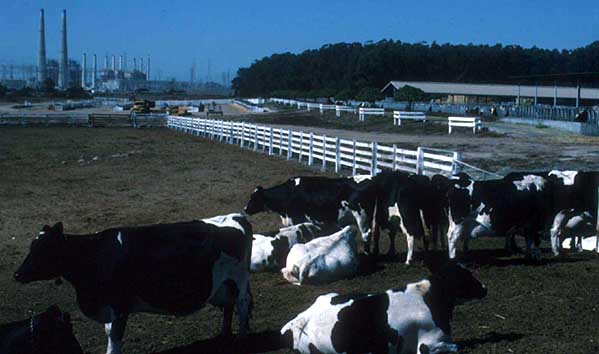
-
MoonGlow Dairy -- for avid birders there may be no better spot in
the entire area than the privately owned MoonGlow
Dairy (photo above). It
has fabulous views of Elkhorn Slough (a scope needed), a freshwater pond
next to the Slough, and the State's best eucalyptus grove. It is located
1.2 miles east of Highway 1 off Dolan Road. I was first able to arrange
birding access here about 20 years ago, and the owners -- Louis & Carol
Calcagno -- have welcomed birders ever since. However, this is an active
dairy operation and there are important rules you must know before birding
here. CLICK HERE
FOR A SEPARATE PAGE ON BIRDING AT MOONGLOW DAIRY; the page also highlights
some of the rarities which have occurred. It is the active operation of
the dairy that attracts huge flocks of blackbirds (Tricoloreds in huge
numbers except in spring when they return to breeding colonies), and it
is the dairy's active management of the freshwater pond that creates duck
habitat in winter/spring and shorebird habitat in fall. The pond (below)
is the single best freshwater pond in Monterey County and it would not
exist except for the dairy. It is one of the most important resources on
the Slough. Please remember to be on your best behavior here, to park well
away from dairy operations, and to drive slowly on the dirt roads. I (Don
Roberson) feel a special responsibility here since none of us would have
access but for the groundwork laid two decades ago.

-
Elkhorn Slough Estuarine Research Reserve -- Elkhorn Slough E.R.R.
is open to the public daily 9 a.m.-5 p.m.Wednesday through Sunday
(there is an entrance fee). It is located about 3 miles north of Dolan
Road on Elkhorn Road (there are signs). The Reserve protects an amazing
variety of habitats, including tidal mudflat, tidal sloughs, a few freshwater
ponds, coastal grasslands, and live oak woodlands. There is a very fine
visitor's
center and many miles of peaceful trails; obtain a map and information
at the visitor's center. Some very important breeding colonies occur here
for Caspian Terns (on an island in the tidal sloughs) and for Great Blue
Herons, Great Egrets, and Double-crested Cormorants (in an old eucalyptus
grove next to a small freshwater pond). The grasslands host White-tailed
Kites and Red-shouldered Hawks, and the oak woodlands have Oak Titmice,
Chestnut-backed Chickadees, Nuttall's Woodpeckers, and Hutton's Vireos.
Indeed, it was the wide variety of habitats within a short distance that
enabled a local team to set what was then an all-time "Big Sit" record
here (117 species on 31 Oct 1982 from a flatbed truck sitting on the hill
overlooking the "Five Fingers" area; there is a nice bench here now). The
entire wetland area are prime hunting grounds for Peregrine Falcons, Ospreys,
and Merlins (in fall/winter).
-
Kirby Park and Elkhorn Road -- north of Elkhorn Slough E.R.R.,
Elkhorn
Road follows the edge of wetlands and is therefore lined with
birds. A small wetland at the intersection of Strawberry Road is a traditional
site for the few Lesser Yellowlegs that winter locally; look also for flocks
of wigeon (in winter; search them for the occasional Eurasian) and phalaropes
(in spring & fall). There is an overlook pullout about a mile north
of here to view marshland with lots of egrets and ducks, and then comes
the access road to Kirby Park. There is a lot of parking adjacent to the
Slough and a boat ramp. A boardwalk meanders north along the Slough. Lots
of rarities here over the years including White-faced Ibis, Tufted Duck,
and even Long-eared Owl (in the first willow patch right of the boardwalk).
When the tide is high, Common and Red-throated Loons can be upslough to
this point. There once was a small population of Clapper Rail in the pickleweed
here, but all were lots to non-native Red Foxes by the 1980s. Farther north,
Elkhorn Slough crosses the upper end of Elkhorn Slough where you can scope
both directions. Ducks and a few geese in winter; terns and shorebirds
in summer & fall.
-
Elkhorn Slough itself is accessed by boat. I recommend Elkhorn
Slough Safari pontoon boat trips which are led by naturalists. You
can also join kayak trips up the Slough and around Moss Landing harbor.
-
Out-of-towners may obtain private tours from Elkhorn Slough area resident
Rick Fournier at Monterey
Birding Adventures (for a fee).
A separate photo page on MoonGlow Dairy and its birds
is HERE:
A complete MoonGlow Dairy list is on-line HERE;
A photo gallery of Elkhorn Slough vagrants is on-line HERE
I thank Rita Carratello, Steve Bailey, Todd Newberry, Mark
Silberstein, Steve Rovell, and Roger Wolfe for comments on an earlier version
of this page. |
Literature cited:
Roberson, D. 1985. Monterey Birds. Monterey Pen. Audubon Soc.,
Carmel, CA.
Silberstein, M., and E. Campbell. 1989. Elkhorn Slough. Monterey
Bay Aquarium, Monterey.
TOP
GO TO MONTEREY
COUNTY PAGE
GO TO HOME PAGE
GO TO
IDENTIFICATION PAGE
GO TO BIRDING THE
WORLD PAGE
GO TO BIRD FAMILIES
OF THE WORLD
Page created 5-23 Sep 2000 |
 By
far the best waterbird habitat in Monterey County is the Moss Landing/Elkhorn
Slough vicinity; indeed, this tidal slough and adjacent freshwater ponds
combine for some of the best birding in all of North America. It has been
recognized as an Important Bird Area (IBA) of international significance.
Along with the much larger San Francisco & Humboldt bays farther north,
it is a principal staging and feeding area for migratory shorebirds.
By
far the best waterbird habitat in Monterey County is the Moss Landing/Elkhorn
Slough vicinity; indeed, this tidal slough and adjacent freshwater ponds
combine for some of the best birding in all of North America. It has been
recognized as an Important Bird Area (IBA) of international significance.
Along with the much larger San Francisco & Humboldt bays farther north,
it is a principal staging and feeding area for migratory shorebirds.
 Mark
Silberstein's wonderful aerial photo shows essentially all of Elkhorn Slough
and Moss Landing harbor. Locate principal sites, especially those of birding
interest, on the legend (left) and then find them on Mark's overview photo
(below). This view is looking east from Monterey Bay. Highway runs through
the center of the photo; to the north (out the upper left side of the photo)
this road goes to Santa Cruz, and to the south (lower right side) it heads
toward Monterey. Highway 1 crosses Elkhorn Slough at the lower right center
of the shot; the huge power plant (built by PG&E, now run by Duke Power)
is just south (right) of that prominent bridge.
Mark
Silberstein's wonderful aerial photo shows essentially all of Elkhorn Slough
and Moss Landing harbor. Locate principal sites, especially those of birding
interest, on the legend (left) and then find them on Mark's overview photo
(below). This view is looking east from Monterey Bay. Highway runs through
the center of the photo; to the north (out the upper left side of the photo)
this road goes to Santa Cruz, and to the south (lower right side) it heads
toward Monterey. Highway 1 crosses Elkhorn Slough at the lower right center
of the shot; the huge power plant (built by PG&E, now run by Duke Power)
is just south (right) of that prominent bridge.




